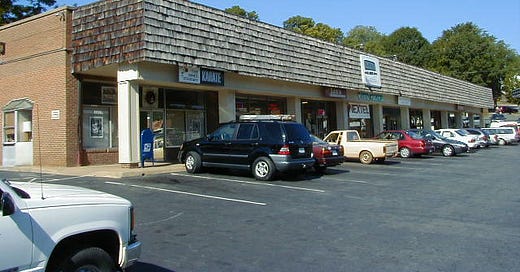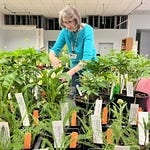In today’s Substack-fueled shout-out, Code for Charlottesville is seeking volunteers with tech, data, design, and research skills to work on community service projects. Founded in September 2019, Code for Charlottesville has worked on projects with the Legal Aid Justice Center, the Charlottesville Fire Department, and the Charlottesville Office of Human Rights. Visit the Code for Charlottesville website to learn more, including details on three projects that are underway.
On this installment:
Albemarle’s Planning Commission endorses the Housing Albemarle plan
Charlottesville will to hold a design public hearing tonight for Fontaine Street pedestrian and bike upgrade
Woodward Properties purchases a major site on Cherry Avenue
Virginia is in the second day of a new state of emergency declared by Governor Ralph Northam to deal with the shutdown of the Colonial Pipeline, which is the primary source of gasoline in the Commonwealth as well as other southeast states.
“While current gasoline reserves in the Commonwealth are sufficient to address immediate supply concerns, a long-term disruption in the pipelines will require transportation of fuel and other oil-derivatives via interstate and state roadways,” reads the order.
Among other things, the executive order enacts a provision intended to fight price gouging, allows state and local services to coordinate on emergency services, and allows for agency heads to conduct some contract purchases outside of the normal process.
Have you changed your habits for the day? Did you go looking for fuel? I’d love to hear your stories.

A major commercial property and several vacant residential lots in Fifeville are under new ownership. Woodard Properties has purchased the Cherry Avenue Shopping Center for $1.9 million and five vacant lots behind it for $1.4 million. Anthony Woodward said in an email that there are no plans to develop the property and the purchase is an investment. The commercial property is within the Cherry Avenue zoning corridor and the residential lots are zoned R-2. Earlier this year, Council adopted the Cherry Avenue Small Area Plan as an advisory guide for future development.

It has now been 18 months since Albemarle County and Charlottesville opted to end participation with the University of Virginia in a public body called the Planning and Coordination Council. The PACC convened for over three decades in open sessions before giving way to a closed-door body known as the Land Use and Environmental Planning Committee (LUEPC), which met last on April 16.
Planning Commission Chair Hosea Mitchell sits on the LUPEC body and updated his colleagues last night on a presentation on UVa’s plans for their property at the intersection of Emmet and Ivy Road.
“The corridor starts at the intersection and Emmet and Ivy and runs all the way down to Copeley,” Mitchell said. “UVA is going to build and manage and own a hotel there. And they’re going to build a manage a convention center there and it will be the largest convention center in our region. And what I really like about this is that even though it is going to be UVA owned and operated, it will be a tax-generating entity for our region, so good news there.”
Mitchell said the new UVA School of Data Science will also operate out of the Emmet-Ivy area. He said LUEPC members learned about a couple of other projects, but those are not ready to be disclosed to the public yet.

UVa is also a participant in a VDOT-funded project known as the Emmet Street Streetscape which seeks to make it safer and more welcoming to walk or bike along Emmet Street between Ivy Road and Arlington Boulevard. This was funded in the first round of VDOT’s Smart Scale process at $12.1 million. Construction is expected to begin in the spring of 2023 according to a schedule on the project website.
Mitchell also gave an update on the $8.6 million project to improve the intersection of Barracks Road and build a wider pathway on Barracks up toward Preston Avenue.
“They’re hoping to begin this in the spring of 2023 and looking worse case to be wrapping this up in early 2025,” Mitchell said.

Another project funded in that first round is the $11.7 million Fontaine Avenue Streetscape, which has its design public hearing tonight. That’s a key step in the process in how a VDOT project moves from concept to construction. A video that will be shown on the webinar is already posted on the project website. The narrator explains that there are four goals of the project. (meeting materials)
“In line with the city of Charlottesville overall transportation goals, the project seeks to make Fontaine Avenue a complete street which improves accommodations for all users, ensuring safe passage for pedestrians and bicyclists, understanding that this serves as a gateway corridor into the city and ensuring that the impression is attractive, and improving access to local facilities and ensuring these connections are also easily accessed by pedestrians, bicyclists, and transit users.”
You can watch the presentation at any time on the project website and see an animation of what the project might look like. As with the other two projects, the goal is to have this project under construction in the spring of 2023. (review the materials)

The cost of housing is one of the most pressing issues in our community. This is an affluent place. With many very wealthy individuals, the annual area median income skews the federal definitions that set levels of subsidization for housing. Charlottesville City Council adopted a new affordable housing update in March. Albemarle County is also updating its housing policy and a draft went before the Planning Commission on May 4. Stacy Pethia is the county’s housing coordinator. (read the May 4 draft)
“The recommendations to update [the plan] came out of the 2019 Housing Needs Assessment that was released by the Thomas Jefferson Planning District Commission,” Pethia said. (link)
The plan update takes into account population projections from the Weldon Cooper Center at the University of Virginia which shows Albemarle continuing to grow in the next couple of decades to 138,485 by 2020, an increase of over 27,000 people over the current estimate. The plan has 12 objectives and dozens of strategies.
“And these strategies include increasing the amount of affordable housing required in special use permits and rezoning applications from 15 percent to 20 percent [and] expanding the definition of affordable housing to include workforce housing category,” Pethia said.
There are many other strategies, such as finding ways to lower the cost to connect to water and sewer, as well as reduced regulatory burdens for projects with additional below-market units. Some short-term ideas include exploring the idea of using county-owned land to develop permanent below-market units, creation of an affordable housing trust fund, creation of an affordable housing committee in the county, and increased partnerships with public and private groups to build more units.
Luis Carrazana, the University of Virginia’s not-voting representative on the Albemarle Planning Commission, noted that a home priced to sell to someone at 60 percent of the area median income is still beyond the reach of many.
“We’re talking about a home that’s over $200,000,” Carrazana said. “I guess it depends on your definition of affordable. We’re in a high AMI area.”
There’s also language in the plan about renovating existing houses that are currently below market. However, Chair Julian Bivins said that can make some residents skittish about speaking up.
“People are nervous about saying something because they don’t want to be displaced by their landlords or they just don’t want to go out and engage with ‘authorities’ because they don’t want that kind of attention,” Bivins said.
Bivins also noted that many of Albemarle’s residents make their money through existing wealth, and not through employment.
“And how do we have this conversation in our community about how do we increase or how do we attract or what do we do to bring [payrolls] here so people can think about climbing up or having ladders they can ascend for better salaries and for better compensation?” Bivins asked.
During the public hearing, the town administrator for Scottsville said that incorporated section of Albemarle would like to work with the county to provide some space for housing.
“Town Council adopted an updated Comprehensive Plan in 2018 and then followed up with two planning grants and a West Downtown Small Area Plan in 2020,” said Matt Lawless. “I expect to see about ten percent population growth over the past decade when Census results come out and our Comp Plan calls for roughly doubling the population by 2040.”
Lawless said the zoning will be changed to allow for quadplexes in town and to encourage upstairs apartments downtown. He himself lives in one of these units and pays less than a thousand a month in rent. The Planning Commission agreed that Scottsville should be listed as a partner.
The Board of Supervisors will have their public hearing on the plan on June 16. In the meantime, you can watch the entire public hearing at the Albemarle Planning Commission at this link, which goes right to the item.














Share this post